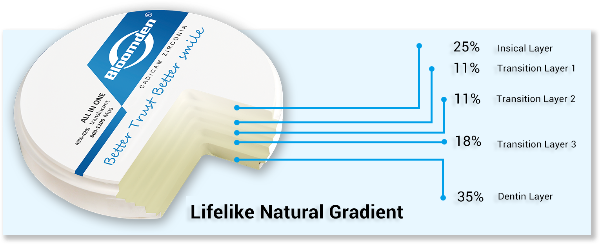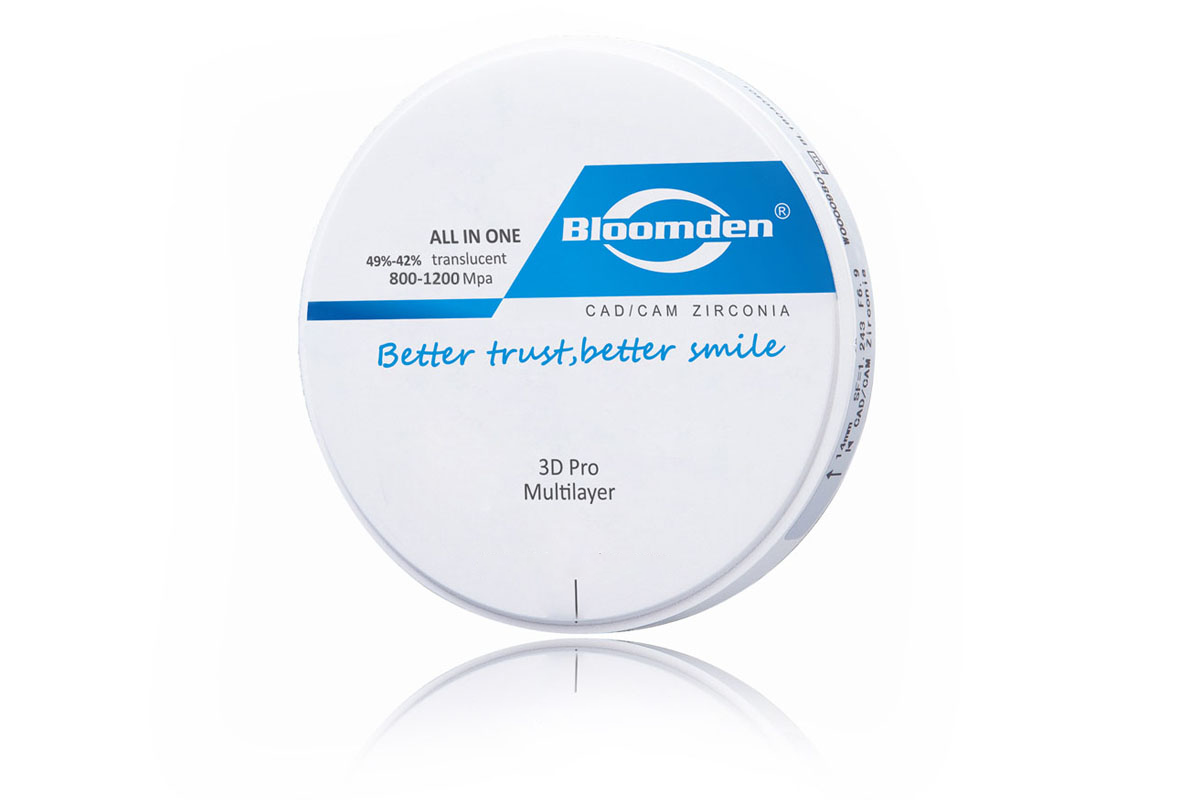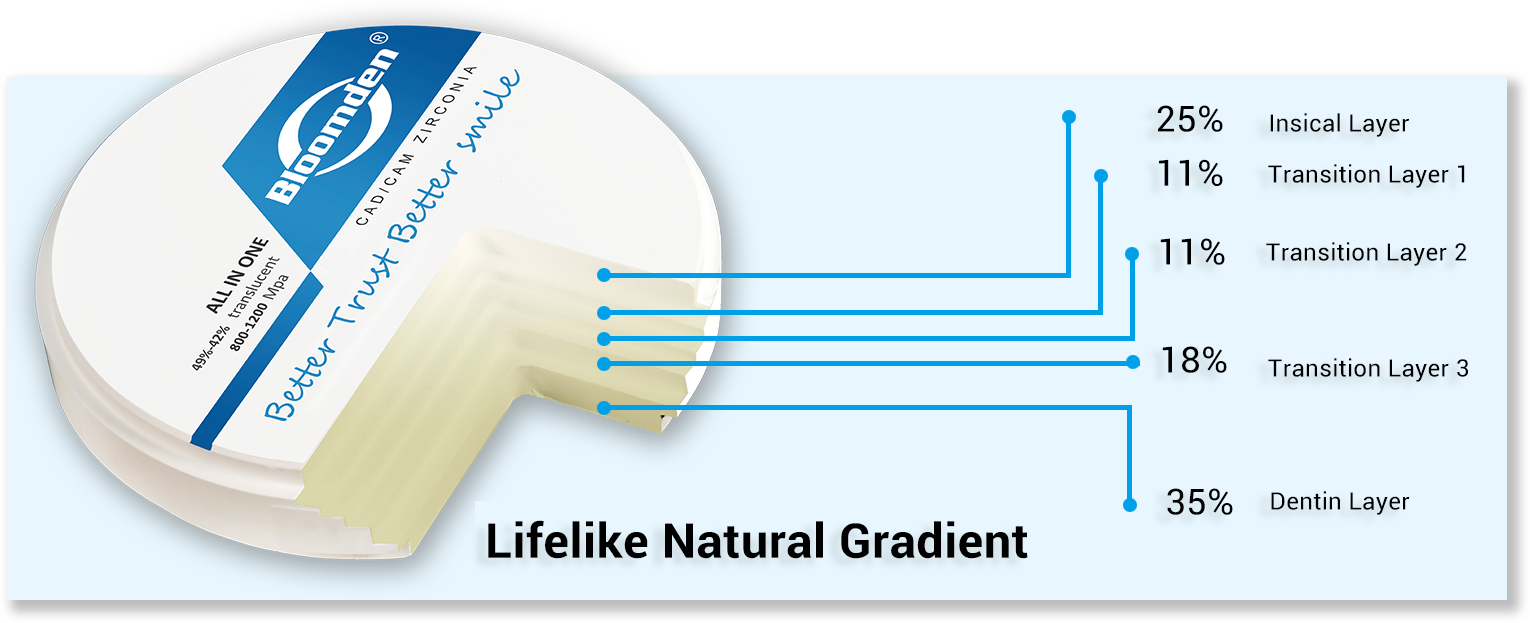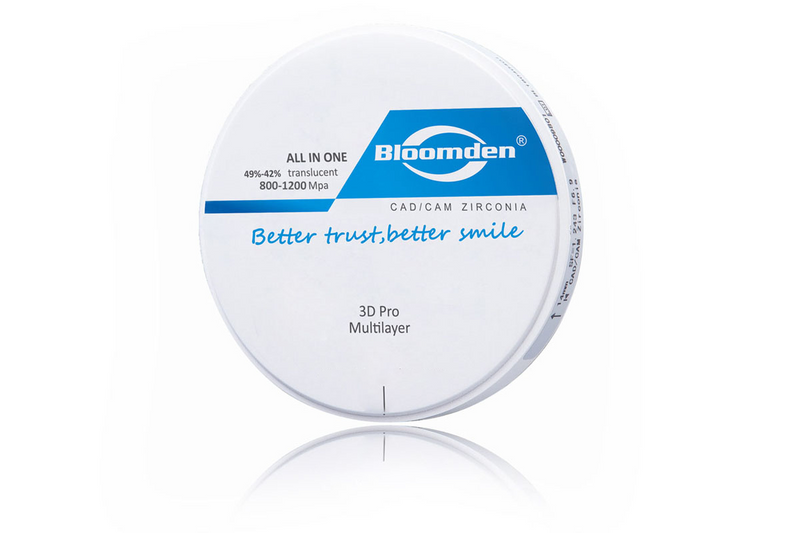Zirconia discs

Experience Esthetics Strength & Efficiency
3D-Pro multilayer zirconia is a dental restorative material designed for crowns and bridges, offering a flexural strength range of 65-1100 MPa and a fracture resistance of up to 6 MPa 1/2. It features a high-speed sintering cycle, ensuring strength, translucency, and aging resistance simultaneously.
Related products
Experience Esthetics Strength & Efficiency
3D-Pro multilayer zirconia is a dental restorative material designed for crowns and bridges, offering a flexural strength range of 65-1100 MPa and a fracture resistance of up to 6 MPa 1/2. It features a high-speed sintering cycle, ensuring strength, translucency, and aging resistance simultaneously.
- Degradation and Transformation: Degradation of zirconia occurs due to tetragonal to monoclinic transformation, especially at temperatures of 200-300°C, leading to micro and macro-cracking. The addition of stabilizers such as yttria can slow down this transformation.
- Crystal Phase Systems: Zirconia exhibits different crystal phases (monoclinic, tetragonal, and cubic) depending on temperature and yttria content. Higher yttria content stabilizes tetragonal and cubic phases, influencing translucency and mechanical properties.
- Thermal and Optical Properties: Zirconia has low thermal conductivity and specific thermal expansion characteristics. Control over alumina content and yttria content affects light translucency and scattering, impacting aesthetic properties.
- Flexural Strength: Flexural strength decreases with increasing yttria content. However, 3D-Pro offers a wide range of flexural strengths suitable for various dental applications.
- Monoclinic Resistance: Unique microstructure and chemical formulation of 3D-Pro resist aging degradation, preventing the shift from cubic to monoclinic phase, which enhances its longevity and structural integrity.
What is a Zirconia Disc?
A zirconia disc is a specialized dental material used extensively in modern dentistry for the fabrication of high-quality dental prostheses, including crowns, bridges, and implant-supported restorations. It is primarily composed of zirconium dioxide (ZrO2), a biocompatible ceramic known for its exceptional mechanical properties and aesthetic benefits. Zirconia discs are available in various formulations, including monolithic and multilayered options, each tailored to specific clinical needs.
How Zirconia Discs are Made
-
Material Preparation: Zirconium dioxide powder undergoes meticulous processing to achieve a fine particle size and homogenous distribution of additives like yttria, which stabilize the crystal structure.
-
Formulation: The prepared zirconia powder is mixed with stabilizers and other additives to control properties such as translucency, strength, and color.
-
Shaping: Through advanced CAD/CAM technology, the zirconia mixture is shaped into discs of precise dimensions that match the intended dental restoration.
-
Sintering: The shaped zirconia discs undergo a high-temperature sintering process, where individual particles fuse together to form a dense, solid structure with superior mechanical strength.
-
Finishing: After sintering, the zirconia discs are meticulously finished to achieve smooth surfaces and precise margins necessary for dental restorations.
Applications in Dentistry
Zirconia discs are versatile and find extensive use across various dental applications:
-
Crowns and Bridges: Zirconia discs are widely used to fabricate highly durable and esthetically pleasing crowns and bridges that blend seamlessly with natural teeth.
-
Implant-Supported Restorations: They are also utilized for manufacturing implant-supported crowns and bridges due to their excellent biocompatibility and mechanical strength.
-
Dental Implant Abutments: Zirconia discs are employed in creating customized implant abutments that offer superior aesthetics and long-term stability.
-
Inlays and Onlays: They are used for fabricating inlays and onlays that restore damaged teeth conservatively while providing strength and longevity.
What to Look for When Purchasing Zirconia Discs?
Green Flags:
-
Quality Standards: Look for zirconia discs that meet international quality standards (e.g., ISO certification), ensuring consistent material properties and performance.
-
Translucency Options: Opt for discs offering a range of translucency levels to achieve natural-looking restorations.
-
Biocompatibility: Ensure the discs are biocompatible and free from harmful substances, ensuring patient safety.
-
Manufacturer Support: Choose discs from manufacturers offering comprehensive technical support and training to optimize their use in your practice.
Red Flags:
-
Inconsistent Quality: Beware of discs with inconsistent translucency or strength, which can compromise the final restoration's aesthetics and durability.
-
Lack of Certification: Avoid discs without proper certification or regulatory compliance, as they may not meet safety and performance standards.
-
Poor Marginal Fit: Discs that do not provide precise margins can lead to restoration failure and compromise patient oral health.
-
Limited Shade Options: Limited shade availability may restrict your ability to match restorations seamlessly with natural dentition.
Why Buy Zirconia Discs Online?
Purchasing zirconia discs online offers several advantages:
-
Price: Online suppliers often offer competitive pricing due to reduced overhead costs, allowing for cost savings compared to traditional distributors.
-
Convenience: Ordering online provides convenience, with 24/7 access to a wide range of zirconia discs and related dental materials from the comfort of your office or home.
-
Product Variety: Online platforms typically offer a diverse selection of zirconia discs, including different shades, sizes, and formulations, catering to various clinical needs.
-
Customer Reviews and Ratings: Access to customer reviews and ratings helps in making informed purchasing decisions based on real user experiences.
Additional Considerations
-
Customization: Some manufacturers offer custom shading services or personalized formulations, allowing for tailored solutions to meet specific patient and clinical requirements.
-
Delivery and Shipping: Check for reliable shipping options and delivery timelines to ensure timely receipt of your orders.
-
Technical Support: Look for suppliers who provide robust technical support and resources, including troubleshooting assistance and training opportunities for your team.
Conclusion
Zirconia discs represent a cornerstone in modern restorative dentistry, offering unparalleled strength, esthetics, and versatility. Whether for crowns, bridges, or implant-supported restorations, choosing the right zirconia discs involves careful consideration of quality, performance, and convenience factors. By understanding the manufacturing process, applications, and key purchasing considerations, dental professionals can confidently integrate zirconia discs into their practice, delivering superior patient outcomes and satisfaction.
Ready to Subscribe?

 Duties are now included in the product price
Duties are now included in the product price







